1926-S Buffalo Nickel: Complete Guide to Key Dates and Rarity Factors
Posted on — Leave a commentTo most people, nickels represent pocket change worth five cents. But in April 2008, a single 1926-S Buffalo nickel sold for $322,000 at auction. This was no coincidence, but rather a reflection of the coin’s exceptional rarity and condition. The 1926-S Buffalo nickel is the rarest regular-issue coin in the entire series, with fewer than 1,000 examples surviving today in all grades combined. While some Buffalo nickels trade for face value, others command astronomical premiums. This guide reveals which dates to look for, their key traits, and the history behind their rarity.
What Makes the Buffalo Nickel Special
The Buffalo nickel series combines artistic achievement with inherent design ‘flaws’ that created both beauty and rarity. Watch this brief video to understand how these coins became some of America’s most distinctive currency.
Fraser’s art
James Earle Fraser’s Native American portrait and American bison design replaced the Liberty Head nickel’s classical female profile. Fraser, commissioned to create distinctly American imagery, used living Native American chiefs as models – Iron Tail of the Lakota and Two Moons of the Cheyenne – rather than idealized fictional figures. The reverse featured Black Diamond, an actual bison from New York’s Central Park Zoo. This marked the first time U.S. coinage depicted real American subjects and wildlife instead of mythological goddesses and eagles, creating what Fraser called “truly American” money.
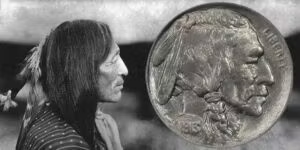
Image: Historical photograph of Iron Tail, one of the Native American chiefs used as a model for Fraser’s Buffalo Nickel design, shown alongside the coin’s obverse.
Source: Dime Library
The date problem
Unlike previous nickels where dates were recessed and protected, Fraser placed the Buffalo nickel’s date in raised relief on the Indian’s shoulder, i.e. one of the coin’s highest points. This positioning made the date the first element to contact surfaces during circulation, causing it to wear away quickly. Within just a few years of use, millions of Buffalo nickels became completely dateless. This design flaw created an unintended rarity scale: coins with sharp, fully readable dates now command significant premiums over their worn counterparts. While Buffalo nickel no date specimens have limited collector value, they represent a fascinating aspect of the series’ design challenges.
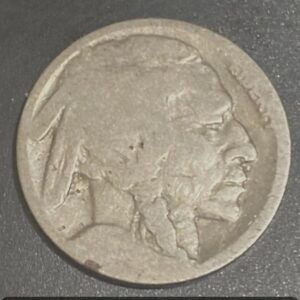
Image: Worn Buffalo Nickel showing completely missing date due to circulation wear on the raised relief design.
Source: NGC
Short series, big impact
Unlike series that ran for decades, Buffalo nickel production lasted only 25 years (1913-1938). This compressed timeline created natural scarcity, especially for low-mintage issues from the San Francisco and Denver mints.
The 1926-S: King of Buffalo Nickels
Low mintage, poor survival rates, and decades of collector pursuit have made the 1926-S the undisputed king of Buffalo nickels.
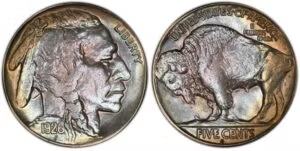
Image: 1926-S Buffalo Nickel obverse and reverse, the key date rarity with only 970,000 minted, showing “S” mint mark.
Source: PCGS
Rarity facts
By 1926, the Buffalo nickel series was winding down, with most mints reducing production significantly. The San Francisco Mint produced only 970,000 Buffalo nickels in 1926, compared to 119,001,420 Philadelphia pieces struck that same year. This makes the 1926-S nearly 123 times scarcer than its common counterpart from the start.
Survival rates
Numismatists estimate fewer than 1,000 examples survive in all grades combined today. Most circulated heavily on the West Coast during the late 1920s and 1930s, with the majority lost to pocket change or melted during metal drives. The typical survivor shows significant wear, with sharp specimens representing perhaps 1-2% of the original mintage.
Grade sensitivity
With so few 1926-S examples surviving, even minor condition differences create dramatic value gaps. A coin that retains sharp design details commands exponentially more than one with worn features. This grade sensitivity exceeds that of common Buffalo nickels, where moving up one or two grade levels might double the value. For the 1926-S, the same grade improvement can increase value by ten times or more.
Complete Key Date Breakdown
Beyond the legendary 1926-S, the Buffalo nickel series contains multiple dates that command significant premiums.
The Big Four Semi-Keys (1924-D, 1924-S, 1925-D, 1925-S)
These four dates represent another tier of Buffalo Nickel rarities, each produced during the series’ declining years when mint output dropped significantly. The 1924-S proves scarcest with only 1,437,000 pieces minted, followed by the 1925-D at 4,450,000, the 1924-D at 5,258,000, and the 1925-S at 6,256,000. While these mintages seem substantial compared to the 1926-S, survival rates remain low due to heavy West Coast and Mountain West circulation patterns that wore most specimens down to Good or Very Good condition.
Denver mint examples from this period often show characteristic weak strikes, particularly in the bison’s shoulder and the Native American’s hair details. San Francisco pieces typically display better overall sharpness but can suffer from die polish lines in the fields. Collectors should examine the area below “FIVE CENTS” carefully, as genuine mint marks show proper depth and positioning that distinguish them from common Philadelphia issues or altered specimens.
The 1935 Semi-Keys (1935-D and 1935-S)
1935-D Production and Characteristics
The Denver Mint struck 12,092,000 Buffalo nickels in 1935, representing a significant drop from earlier 1930s production levels. Denver coins from this year show distinctive die polish lines in the fields and often display weak definition in the bison’s leg muscles due to the facility using older dies longer during this period. The “D” mint mark typically appears slightly smaller and less deeply impressed than on earlier Denver issues.
1935-S Production and Characteristics
San Francisco produced 10,300,000 pieces in 1935, marking the final year of substantial West Coast Buffalo nickel production. These coins typically exhibit superior overall sharpness compared to Denver issues but suffer from characteristic die cracks that run from the rim through the Native American’s shoulder. The “S” mint mark on 1935 issues appears more deeply impressed than on most earlier San Francisco Buffalo nickels.
Strike quality
Both the Denver and San Francisco facilities struggled with die maintenance during 1935, producing coins with notably softer details than their Philadelphia counterparts. This weakness particularly affects the bison’s shoulder fur and the Native American’s hair braids, making well-struck examples especially desirable. Collectors seeking quality 1935 Buffalo nickel specimens should prioritize coins with sharp strikes and full design details over those showing typical mint weaknesses.
The 1936-D: Overlooked Key Date
Mintage reality
While 24,814,000 pieces might seem like a large number, the 1936-D becomes genuinely scarce when compared to the Philadelphia Mint’s massive 119,001,420 production that same year. This nearly 5-to-1 ratio means the Denver issue represents less than 17% of total 1936 Buffalo nickel production, yet many collectors overlook this disparity when focusing on the more famous key dates.
Grade availability
Denver’s characteristic weak strikes during 1936 Buffalo nickel production resulted in coins with soft details from the moment they left the mint. Combined with heavy circulation in western states, finding 1936-D examples in Mint State grades proves exceptionally difficult, with most survivors grading Very Fine or lower. This scarcity in higher grades significantly impacts 1936 Buffalo nickel value, with well-preserved Denver specimens commanding premiums that reflect their true rarity.
The 1937-D 3 Legged Buffalo Nickel
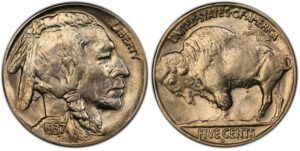
Image: 1937-D Three-Legged Buffalo Nickel obverse and reverse showing the famous error where the buffalo’s front right leg is completely missing.
Source: PCGS
Error story
During 1937 production at the Denver Mint, an overenthusiastic die polisher attempted to remove clash marks from a reverse die by grinding away metal from the surface. This excessive polishing accidentally removed the bison’s right front leg entirely, creating one of the most famous error coins in U.S. Mint history. The damaged die continued striking coins until mint officials discovered the problem, producing several thousand three-legged specimens before replacement. This error dramatically affects 1937 Buffalo nickel value, with three-legged examples commanding substantial premiums over normal strikes.
Identification guide
The genuine 3 legged Buffalo nickel shows complete absence of the bison’s right front leg, with the area appearing as smooth, uninterrupted ground. This differs dramatically from common die wear, which gradually weakens leg details but leaves partial outlines or shadow impressions. The missing leg creates an unnatural gap between the bison’s body and the ground line that cannot be mistaken for normal circulation wear.
1937-D Buffalo Nickel Value breakdown
Even heavily worn three-legged buffalo examples command substantial premiums because the error remains clearly visible regardless of grade. The dramatic visual impact of the missing leg creates instant recognition among collectors, sustaining demand across all condition levels from damaged pieces to pristine mint state examples. This error variety represents the pinnacle of 1937 Buffalo Nickel collecting, with values far exceeding normal Denver strikes from the same year.
Authentication tips
Genuine specimens show specific die markers including a small raised dot below the bison’s belly and characteristic weakness in the “E” of “AMERICA.” The die polishing also created subtle texture differences in the field areas that counterfeiters struggle to replicate convincingly.
Overdate Varieties (1918/7-D, 1914/3)
Technical details
During World War I, the U.S. Mint faced severe cost pressures and material shortages that made die conservation essential. Rather than scrapping 1917-dated dies at year’s end, the Denver Mint repunched them with “8” over the final “7” to create 1918 dies. Similarly, leftover 1913 dies received a “4” punched over the “3” for 1914 production. This wartime economy measure created these distinctive overdate varieties that showcase the mint’s resourcefulness during national crises.
Visual identification
The 1918/7-D shows clear remnants of the underlying “7” beneath the “8,” particularly visible as curved lines extending beyond the “8’s” lower loop. The 1914/3 displays portions of the “3’s” upper and lower curves protruding from behind the “4,” most evident under magnification at the date’s right side. Both overdates require careful examination, as the underlying numerals appear as subtle but definitive shadows.
The 1916 Doubled Die Obverse
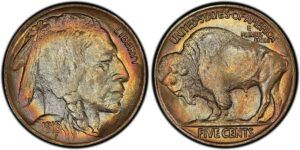
Image: 1916 Buffalo Nickel doubled die obverse and reverse showing the dramatic doubling error in the date digits.
Source: PCGS
Doubling locations
A doubled die error occurs when a coin die receives two slightly misaligned impressions during manufacturing, creating overlapping images on the finished coin. The 1916 Buffalo Nickel doubled die shows this defect most clearly in the date, where the final digits – “16” – appear twice: the original numbers plus a second set offset to the right. This creates a shadow or double-vision effect that makes the date appear blurred or duplicated when examined closely.
Grading considerations
Many 1916 doubled die examples circulated for years before collectors recognized the error, meaning most survivors show significant wear. The doubling remains visible even in lower grades, but mint state examples prove exceptionally valuable due to their rarity and the pristine visibility of the error.
Market position
This variety rivals the 1926-S for supremacy among Buffalo nickel rarities because it combines extreme scarcity with the appeal of a dramatic mint error. Error coins attract both specialists and general error coin collectors, expanding the potential buyer base and driving Buffalo nickel value into six-figure territory for high-grade examples.
Modern Times: The 2005 Buffalo Nickel Comeback
Nearly seventy years after the last Buffalo nickel rolled off mint presses, Fraser’s iconic design returned to American coinage.
Westward Journey series
The U.S. Mint revived Fraser’s bison design in 2005 as part of the Westward Journey nickel series commemorating the Lewis and Clark expedition bicentennial. This marked the first time since 1938 that the beloved buffalo appeared on circulating American coins, generating excitement among both collectors and the general public.
Collectible potential
While most of the 2005 Buffalo nickel coins remain common, certain varieties show premium potential including coins with strong strikes, full steps detail, and pristine surfaces. Special mint set examples and first-day-of-issue specimens attract collector interest beyond face value.
Investment Perspective: The Buffalo Nickel in 2025
Buffalo nickels occupy a unique position in today’s collecting market, offering genuine rarity, often at accessible price points, within the broader spectrum of tangible asset investment options.
Advantages
Affordable entry
Key dates like the 1924-S and 1925-D remain accessible to new collectors, with entry-level examples available at modest premiums. This affordability allows collectors to acquire genuine rarities without the substantial financial commitment required for many other classic American series. Following proven rare coin investing strategies helps collectors focus on quality specimens and undervalued opportunities within the Buffalo nickel market.
Artistic appeal
Fraser’s distinctive Native American and bison imagery attracts collectors beyond traditional numismatists, including Western art enthusiasts and history buffs who appreciate the coins’ cultural significance.
Completion potential
The series’ 25-year span makes complete date and mint mark sets achievable goals, unlike longer series that require decades to assemble.
Considerations
Date visibility
The series’ inherent design weakness means many specimens suffer from partial or complete date loss, requiring careful authentication of readable examples.
Grading costs
Professional grading expenses must be weighed against potential Buffalo nickel value increases, particularly for mid-grade specimens. Understanding numismatic grading standards and certification processes helps collectors determine when third-party authentication justifies the expense.
Conclusion
Buffalo nickels transformed American coinage by replacing classical allegory with authentic American subjects: real Native American chiefs and actual wildlife from the frontier. Fraser’s artistic revolution created coins that captured a vanishing way of life, making them culturally significant beyond their numismatic value.
This cultural importance drives sustained collector demand across all economic levels. While key dates like the 1926-S command astronomical prices, the series also offers affordable semi-keys and common dates that allow participation without major financial commitment. The 25-year production span creates a manageable collecting goal compared to series spanning decades.
Understanding rarity factors, from mintage figures to survival rates to authentication markers, separates successful Buffalo nickel collectors from casual buyers. These coins reward knowledge and patience, offering both historical connection and potential appreciation for those who study the market carefully.
Explore Blanchard’s current Buffalo nickel inventory to discover authenticated examples of these remarkable American coins, backed by decades of numismatic expertise and market knowledge.
FAQs
1. How much is a Buffalo nickel worth?
Buffalo nickel value depends entirely on date, mint mark, and condition. Common dates from the 1930s typically trade near face value in worn condition, while key dates like the 1926-S and error coins like the 1937-D 3 legged Buffalo nickel command substantial premiums regardless of grade.
2. How much is a 2005 Buffalo nickel worth?
Most 2005 Buffalo Nickels remain common and trade at face value since they were produced in large quantities for circulation. However, exceptionally well-preserved examples or coins from special mint sets may carry modest collector premiums.
3. Where is the date on a Buffalo nickel?
The date appears on the obverse of the coin, positioned on the Native American’s shoulder below the portrait. This raised placement made the date vulnerable to wear, causing many Buffalo Nickels to become completely dateless through normal circulation.
4. Where is the mint mark on a Buffalo nickel?
The mint mark is located on the reverse, below the words “FIVE CENTS.” Look for a small “D” (Denver) or “S” (San Francisco) in this position. Coins without mint marks were produced at the Philadelphia Mint.








